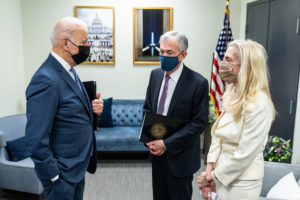
President Joe Biden talks with Jerome Powell, his nominee to remain as the Federal Reserve Chair and Lael Brainard, nominee to be the Federal Reserve Vice Chair, Monday, November 22, 2021, in the South Court Auditorium of the Eisenhower Executive Office Building at the White House. (Official White House Photo by Adam Schultz)
Americans living on Social Security will undoubtedly be happy to receive higher payouts after some of the largest cost of living adjustments (COLAs) seen in forty years kick in. But it’s hard to say if those COLAs will be enough to make up for raging inflation. The Federal Reserve’s decade+ of dumping money into American markets, and Joe Biden’s flagrant spending have paved the way for inflation unlike anything seen since the early 1980s and left retirees and those living on fixed incomes facing choices between things like heat and food. Anne Tergesen reports in The Wall Street Journal:
Social Security checks will be 8.7% bigger in 2023, the largest cost-of-living adjustment to benefits in four decades, the Social Security Administration said Thursday.
The extra funds will provide relief for many of the roughly 70 million Social Security recipients whose budgets have been stretched thin by high inflation and whose nest eggs were walloped by plunging stock and bond markets. The average monthly Social Security check for retired workers will rise to $1,814 in January, up from $1,669 this year.
For the government, this supersize cost-of-living adjustment, or COLA, means paying out more money to retirees, whose ranks are swelling as baby boomers retire. For retirees, however, the COLA will “be a welcome relief to people when they get it this January,” said David Certner, legislative counsel at AARP.
The cost-of-living adjustment is intended to ensure benefits keep pace with inflation. The annual increase is tied to the average inflation for July, August and September, using the Labor Department’s Consumer Price Index for Urban Wage Earners and Clerical Workers. The broader consumer-price index rose 8.2% in September from a year earlier.
Next year’s increase will be the largest since 1981, when benefits rose 11.2%, according to Social Security Administration data. The highest COLA since the program began automatic cost-of-living increases in 1975 was 14.3% in 1980.
Just over 40% of Americans age 65 and older rely on Social Security for half or more of their income, according to an AARP analysis of recent government data. About 20% of recipients in that age group depend on the benefits for 90% or more of their income, the analysis found.
Mr. Certner said soaring inflation has been hard for many retirees to manage. While Social Security benefits rose 5.9% this year, that hasn’t fully kept pace with inflation. Most private-sector pensions don’t have a cost-of-living adjustment, he said, and most other sources of retirement income, such as 401(k) and individual retirement accounts, have declined this year with the markets.
If you’re willing to fight for Main Street America, click here to sign up for my free weekly email.





